Hieronymus Bosch drawings
This is an incomplete list of drawings by Hieronymus Bosch, many of which have survived to the present day. A number represent alternate incarnations or preparatory sketches for his paintings.
Bosch's works are generally organized into three periods of his life dealing with the early works (c. 1470–1485), the middle period (c.1485–1500), and the late period (c. 1500 until his death). According to Stefan Fischer, thirteen of Bosch's surviving paintings were completed in the late period, with seven surviving paintings attributed to his middle period.[1] Bosch's early period is studied in terms of his workshop activity and possibly some of his drawings. There are no surviving paintings attributed to before 1485.
| Image | Details |
|---|---|
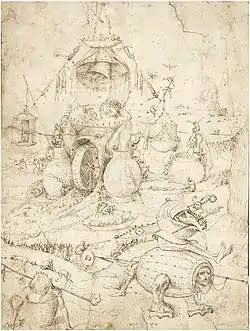 |
Infernal Landscape Type: Pen and brown ink
|
 |
Two monsters Type: Pen drawing This is a two-sided drawing. |
 |
Study of Monsters
Reverse of previous. |
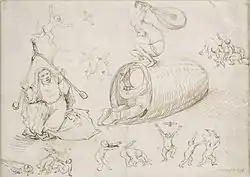 |
Beehive and witches Type: Pen and bistre |
 |
Beggars Type: Pen and bistre It is unknown whether this drawing is by Bosch or Pieter Brueghel the Elder. |
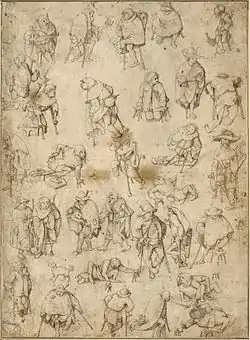 |
Beggars and Cripples Type: Pen and bistre Size: 264 x 198 mm Like the drawing Beggars, it is unknown whether this drawing is by Bosch or Pieter Brueghel the Elder. |
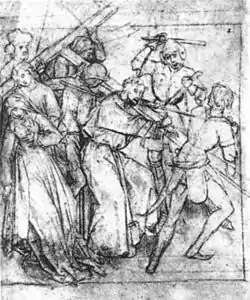 |
Christ Carrying The Cross Type: Pen Size: 236 x 198 mm Formerly attributed to Bosch. |
 |
A comical barber scene Type: Pen and brown ink on black chalk Size: 174 × 207 mm. Location: London, British Museum This sketch would later be made into an engraving by Pieter van der Heyden. |
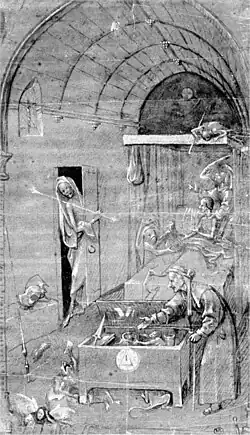 |
Death of the Miser Size: 256 x 149 mm Location: Musée du Louvre, Paris Although originally thought to have been a preparatory drawing for the painting Death and the Miser, it is now believed that the drawing was executed by a follower of Bosch. Examination of the underdrawing of the painting Death and the Miser reveals that Bosch shortened Death's arrow in the final version. The length of the arrow in the drawing is equal to the length of the arrow in the painting, rather than in the underdrawing. The unknown artist of the drawing also embellished details including an orthodox cross below the barrel vault. The assertion that the drawing is of Bosch's hand is used by Lynda Harris to support her theory that Bosch was a practitioner of the Cathar religion. The "Death and the Usurer" drawing is paired with a similar "Ship of Fools Drawing" which has also been erroneously attributed to Bosch. |
_-_Group_of_Ten_Spectators_-_themorgan_128140v_0001.jpg.webp) |
Group of Male Figures Type: Pen Size: 124 x 126 mm Attribution uncertain. |
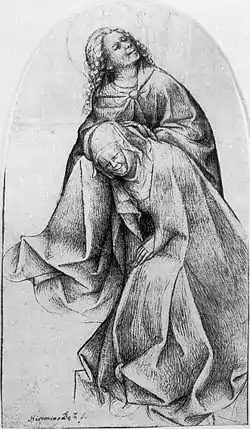 |
Mary and John at the Foot of the Cross Type: Brush Size: 302 x 172 mm |
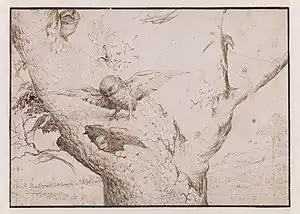 |
Nest of Owls Type: Pen and bistre Size: 140 x 196 mm |
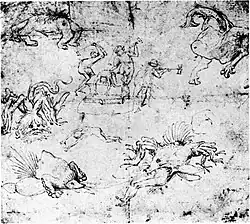 |
Scenes in Hell Type: Pen and bistre Size: 163 x 176 mm Attribution uncertain. |
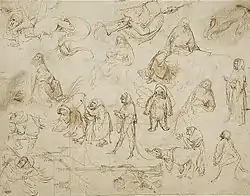 |
Studies Type: Pen and bistre Attribution uncertain |
.jpg.webp) |
Monsters Type: Pen and bistre Size: 318 x 210 mm This is a two-sided drawing. |
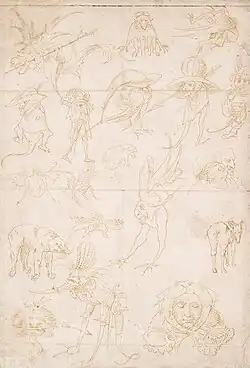 |
Studies of Monsters
Reverse of previous. |
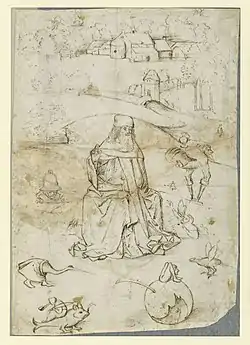 |
Temptation of St Anthony Type: Pen and bistre Attribution uncertain. This sketch would later be made into a painting. |
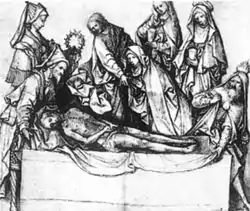 |
The Entombment Date: 1507 Formerly attributed to Bosch. |
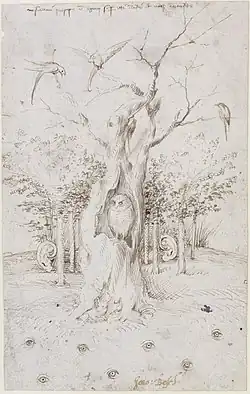 |
The Forest that hears and the field that sees Type: Pen and bistre |
.jpg.webp) |
The Ship of Fools Date: c. 1500 Done after Bosch by an unknown artist. |
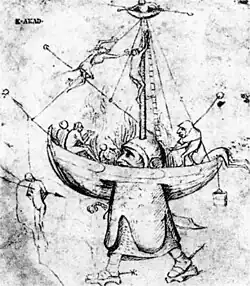 |
Ship in Flames Type: Pen and bistre Attribution uncertain. |
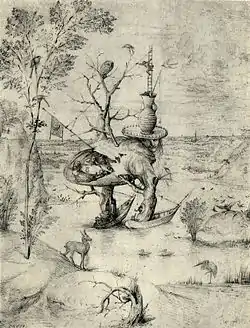 |
Man Tree Date: c.1470s (?) The Tree-Man later (?) appears in the Bosch triptych The Garden of Earthly Delights. |
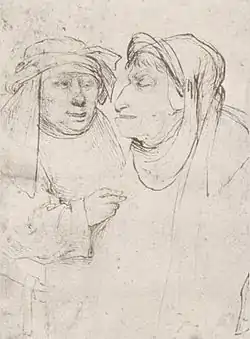 |
Two Caricatured Heads Type: Pen and bistre |
 |
Two Monsters Type: Pen and bistre This is a two-sided drawing. |
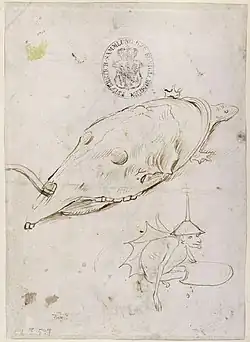 |
Turtle and a winged demon
Reverse of previous. |
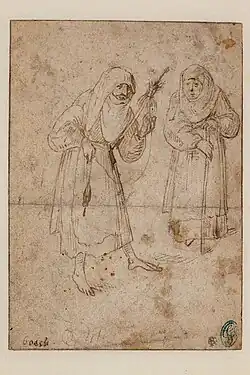 |
Two Witches Type: Pen and bistre |
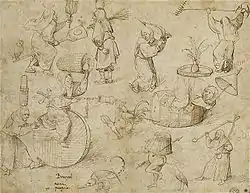 |
Witches Type: Pen and bistre Note: Brueghel's name appears on this drawing, however it is widely accepted as Bosch's. |
See also
References
- Stefan Fischer. Bosch: The Complete Works.